Note
Click here to download the full example code
Basic arithmetic with the quantum Fourier transform (QFT)¶
Author: Guillermo Alonso-Linaje — Posted: 07 November 2022.
Arithmetic is a fundamental branch of mathematics that consists of the study of the main operations with numbers such as addition, multiplication, subtraction and division. Using arithmetic operations we can understand the world around us and solve many of our daily tasks.
Arithmetic is crucial for the implementation of any kind of algorithm in classical computer science, but also in quantum computing. For this reason, in this demo we are going to show an approach to defining arithmetic operations on quantum computers. The simplest and most direct way to achieve this goal is to use the quantum Fourier transform (QFT), which we will demonstrate on a basic level.
In this demo we will not focus on understanding how the QFT is built, as we can find a great explanation in the Xanadu Quantum Codebook. Instead, we will develop the intuition for how it works and how we can best take advantage of it.
Motivation¶
The first question we have to ask ourselves is whether it makes sense to perform these basic operations on a quantum computer. Is the goal purely academic or is it really something that is needed in certain algorithms? Why implement in a quantum computer something that we can do with a calculator?
When it comes to basic quantum computing algorithms like the Deustch–Jozsa or Grover’s algorithm, we might think that we have never needed to apply any arithmetic operations such as addition or multiplication. However, the reality is different. When we learn about these algorithms from an academic point of view, we work with a ready-made operator that we never have to worry about, the oracle. Unfortunately, in real-world situations, we will have to build this seemingly magical operator by hand. As an example, let’s imagine that we want to use Grover’s algorithm to search for magic squares. To define the oracle, which determines whether a solution is valid or not, we must perform sums over the rows and columns to check that they all have the same value. Therefore, to create this oracle, we will need to define a sum operator within the quantum computer.
The second question we face is why we should work with the QFT at all. There are other procedures that could be used to perform these basic operations; for example, by imitating the classical algorithm. But, as we can see in 1, it has already been proven that the QFT needs fewer qubits to perform these operations, which is nowadays of vital importance.
We will organize the demo as follows. Initially, we will talk about the Fourier basis to give an intuitive idea of how it works, after which we will address different basic arithmetic operations. Finally, we will move on to a practical example in which we will factor numbers using Grover’s algorithm.
QFT representation¶
To apply the QFT to basic arithmetic operations, our objective now is to learn how to add, subtract and multiply numbers using quantum devices. As we are working with qubits, —which, like bits, can take the values \(0\) or \(1\)—we will represent the numbers in binary. For the purposes of this tutorial, we will assume that we are working only with integers. Therefore, if we have \(n\) qubits, we will be able to represent the numbers from \(0\) to \(2^n-1\).
The first thing we need to know is PennyLane’s standard for encoding numbers in a binary format. A binary number can be represented as a string of 1s and 0s, which we can represent as the multi-qubit state
where the formula to obtain the equivalent decimal number \(m\) will be:
Note that \(\vert m \rangle\) refers to the basic state generated by the binary encoding of the number \(m\). For instance, the natural number \(6\) is represented by the quantum state \(\vert 110\rangle,\) since \(\vert 110 \rangle = 1 \cdot 2^2 + 1\cdot 2^1+0\cdot 2^0 = 6\).
Let’s see how we would represent all the integers from \(0\) to \(7\) using the product state of three qubits, visualized by separate Bloch spheres for each qubit.
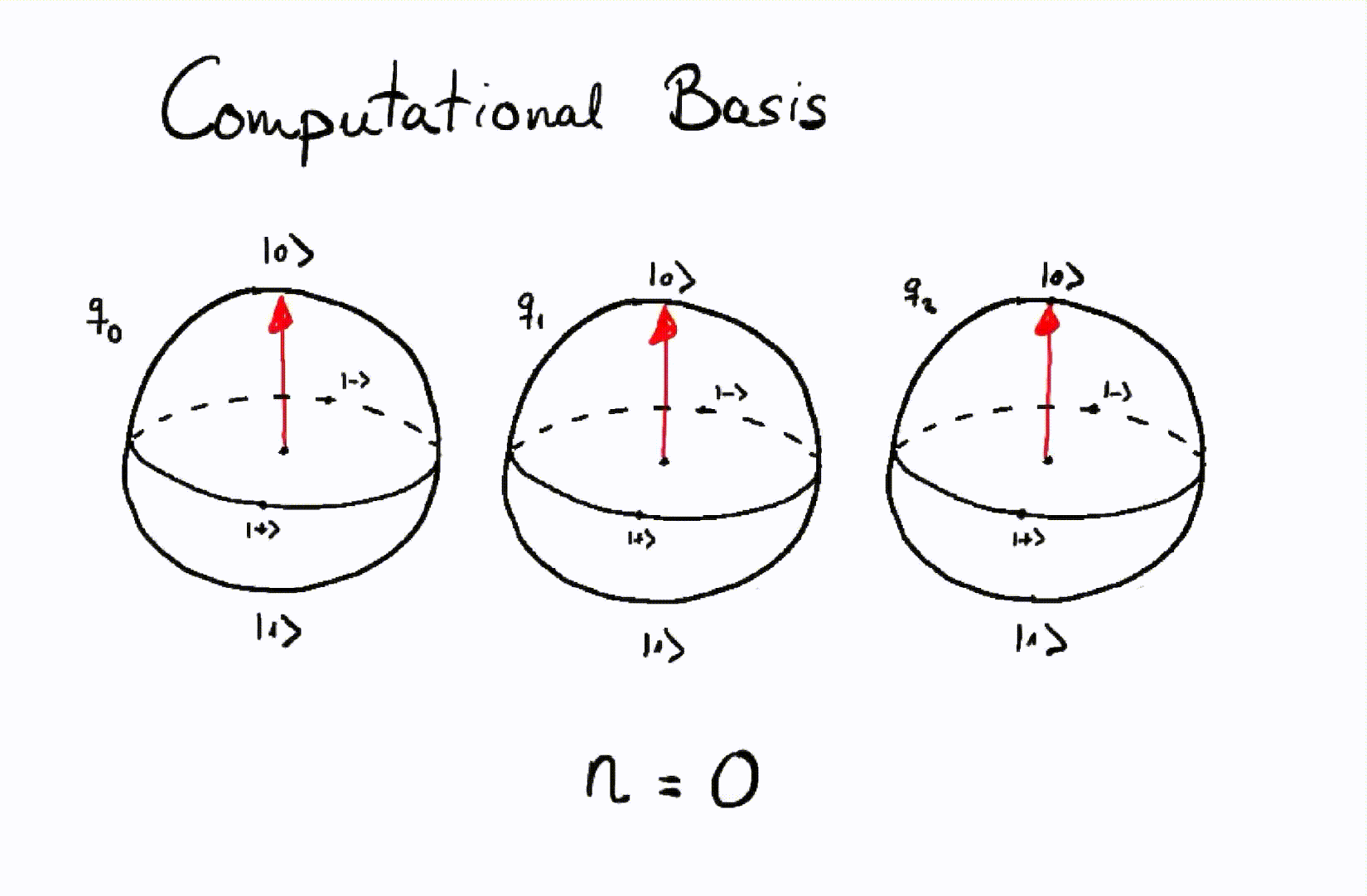
Representation of integers using a computational basis of three qubits.¶
Note
The Bloch sphere is a way of graphically representing the state of a qubit. At the top of the sphere we place the state \(\vert 0 \rangle,\) at the bottom \(\vert 1 \rangle\), and in the rest of the sphere we will place the possible states in superposition. It is a very useful representation that helps better visualize and interpret quantum gates such as rotations.
We can use
the qml.BasisEmbedding
template to obtain the binary representation in a simple way.
Let’s see how we would code the number \(6\).
import pennylane as qml
import matplotlib.pyplot as plt
dev = qml.device("default.qubit", wires=3)
@qml.qnode(dev)
@qml.compile()
def basis_embedding_circuit(m):
qml.BasisEmbedding(m, wires=range(3))
return qml.state()
m = 6 # number to be encoded
qml.draw_mpl(basis_embedding_circuit, show_all_wires=True)(m)
plt.show()
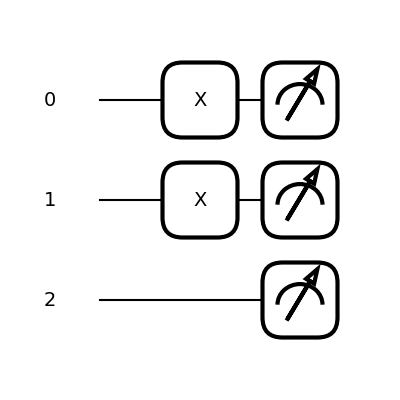
As we can see, the first qubit—the \(0\)-th wire—is placed on top and the rest of the qubits are below it. However, this is not the only way we could represent numbers. We can also represent them in different bases, such as the so-called Fourier base.
In this case, all the states of the basis will be represented via qubits in the XY-plane of the Bloch sphere, each rotated by a certain amount.
How do we know how much we must rotate each qubit to represent a certain number? It is actually very easy! Suppose we are working with \(n\) qubits and we want to represent the number \(m\) in the Fourier basis. Then the \(j\)-th qubit will have the phase:
Now we can represent numbers in the Fourier basis using three qubits:
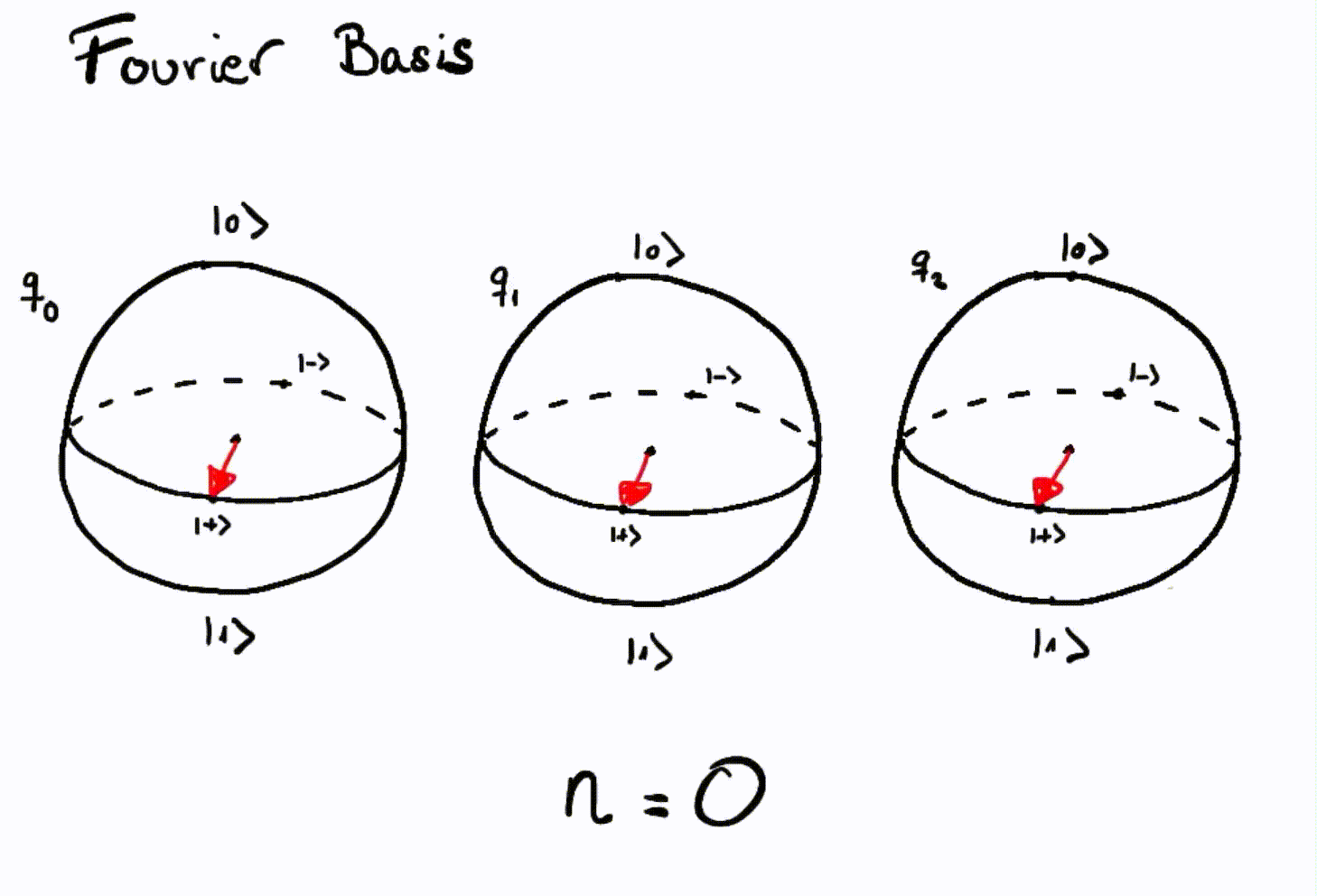
Representation of integers using the Fourier basis with three qubits¶
As we can see, the third qubit will rotate \(\frac{1}{8}\) of a turn counterclockwise with each number. The next qubit rotates \(\frac{1}{4}\) of a full turn and, finally, the first qubit rotates half a turn for each increase in number.
Adding a number to a register¶
The fact that the states encoding the numbers are now in phase gives us great flexibility in carrying out our arithmetic operations. To see this in practice, let’s look at the situation in which want to create an operator Sum such that:
The procedure to implement this unitary operation is the following:
We convert the state from the computational basis into the Fourier basis by applying the QFT to the \(\vert m \rangle\) state via the
QFToperator.We rotate the \(j\)-th qubit by the angle \(\frac{2k\pi}{2^{j}}\) using the \(R_Z\) gate, which leads to the new phases, \(\frac{2(m + k)\pi}{2^{j}}\).
We apply the QFT inverse to return to the computational basis and obtain \(m+k\).
Let’s see how this process would look in PennyLane.
import pennylane as qml
from pennylane import numpy as np
n_wires = 4
dev = qml.device("default.qubit", wires=n_wires, shots=1)
def add_k_fourier(k, wires):
for j in range(len(wires)):
qml.RZ(k * np.pi / (2**j), wires=wires[j])
@qml.qnode(dev)
def sum(m, k):
qml.BasisEmbedding(m, wires=range(n_wires)) # m encoding
qml.QFT(wires=range(n_wires)) # step 1
add_k_fourier(k, range(n_wires)) # step 2
qml.adjoint(qml.QFT)(wires=range(n_wires)) # step 3
return qml.sample()
print(f"The ket representation of the sum of 3 and 4 is {sum(3,4)}")
Out:
The ket representation of the sum of 3 and 4 is [0 1 1 1]
Perfect, we have obtained \(\vert 0111 \rangle\), which is equivalent to the number \(7\) in binary!
Note that this is a deterministic algorithm, which means that we have obtained the desired solution by executing a single shot. On the other hand, if the result of an operation is greater than the maximum value \(2^n-1\), we will start again from zero, that is to say, we will calculate the sum modulo \(2^n-1.\) For instance, in our three-qubit example, suppose that we want to calculate \(6+3.\) We see that we do not have enough memory space, as \(6+3 = 9 > 2^3-1\). The result we will get will be \(9 \pmod 8 = 1\), or \(\vert 001 \rangle\) in binary. Make sure to use enough qubits to represent your solutions! Finally, it is important to point out that it is not necessary to know how the QFT is constructed in order to use it. By knowing the properties of the new basis, we can use it in a simple way.
Adding two different registers¶
In this previous algorithm, we had to pass to the operator the value of \(k\) that we wanted to add to the starting state. But at other times, instead of passing that value to the operator, we would like it to pull the information from another register. That is, we are looking for a new operator \(\text{Sum}_2\) such that
In this case, we can understand the third register (which is initially at \(0\)) as a counter that will tally as many units as \(m\) and \(k\) combined. The binary decomposition will make this simple. If we have \(\vert m \rangle = \vert \overline{q_0q_1q_2} \rangle\), we will have to add \(1\) to the counter if \(q_2 = 1\) and nothing otherwise. In general, we should add \(2^{n-i-1}\) units if the \(i\)-th qubit is in state \(\vert 1 \rangle\) and 0 otherwise. As we can see, this is the same idea that is also behind the concept of a controlled gate. Indeed, observe that we will, indeed, apply a corresponding phase if indeed the control qubit is in the state \(\vert 1\rangle\). Let us now code the \(\text{Sum}_2\) operator.
wires_m = [0, 1, 2] # qubits needed to encode m
wires_k = [3, 4, 5] # qubits needed to encode k
wires_solution = [6, 7, 8, 9] # qubits needed to encode the solution
dev = qml.device("default.qubit", wires=wires_m + wires_k + wires_solution, shots=1)
n_wires = len(dev.wires) # total number of qubits used
def addition(wires_m, wires_k, wires_solution):
# prepare solution qubits to counting
qml.QFT(wires=wires_solution)
# add m to the counter
for i in range(len(wires_m)):
qml.ctrl(add_k_fourier, control=wires_m[i])(2 **(len(wires_m) - i - 1), wires_solution)
# add k to the counter
for i in range(len(wires_k)):
qml.ctrl(add_k_fourier, control=wires_k[i])(2 **(len(wires_k) - i - 1), wires_solution)
# return to computational basis
qml.adjoint(qml.QFT)(wires=wires_solution)
@qml.qnode(dev)
def sum2(m, k, wires_m, wires_k, wires_solution):
# m and k codification
qml.BasisEmbedding(m, wires=wires_m)
qml.BasisEmbedding(k, wires=wires_k)
# apply the addition circuit
addition(wires_m, wires_k, wires_solution)
return qml.sample(wires=wires_solution)
print(f"The ket representation of the sum of 7 and 3 is "
f"{sum2(7, 3, wires_m, wires_k, wires_solution)}")
qml.draw_mpl(sum2, show_all_wires=True)(7, 3, wires_m, wires_k, wires_solution)
plt.show()
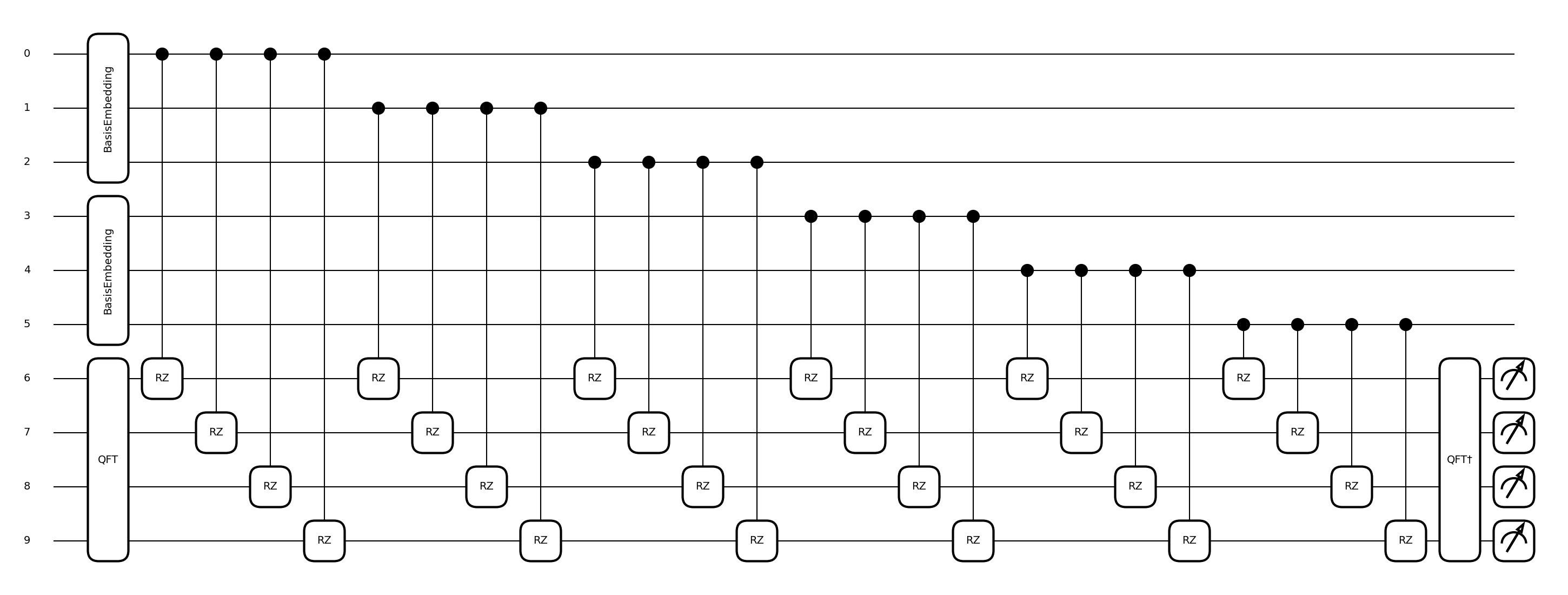
Out:
The ket representation of the sum of 7 and 3 is [1 0 1 0]
Great! We have just seen how to add a number to a counter. In the example above, we added \(3 + 7\) to get \(10\), which in binary is \(\vert 1010 \rangle\).
Multiplying qubits¶
Following the same idea, we will see how easily we can implement multiplication. For this purpose we’ll take two arbitrary numbers \(m\) and \(k\) to carry out the operation. This time, we look for an operator Mul such that
To understand the multiplication process, let’s work with the binary decomposition of \(k:=\sum_{i=0}^{n-1}2^{n-i-1}k_i\) and \(m:=\sum_{j=0}^{l-1}2^{l-j-1}m_i\). In this case, the product would be:
In other words, if \(k_i = 1\) and \(m_i = 1\), we would add \(2^{n-i-1} \cdot 2^{l-j-1}\) units to the counter, where \(n\) and \(l\) are the number of qubits with which we encode \(m\) and \(k\) respectively. Let’s code to see how it works!
wires_m = [0, 1, 2] # qubits needed to encode m
wires_k = [3, 4, 5] # qubits needed to encode k
wires_solution = [6, 7, 8, 9, 10] # qubits needed to encode the solution
dev = qml.device("default.qubit", wires=wires_m + wires_k + wires_solution, shots=1)
n_wires = len(dev.wires)
def multiplication(wires_m, wires_k, wires_solution):
# prepare sol-qubits to counting
qml.QFT(wires=wires_solution)
# add m to the counter
for i in range(len(wires_k)):
for j in range(len(wires_m)):
coeff = 2 ** (len(wires_m) + len(wires_k) - i - j - 2)
qml.ctrl(add_k_fourier, control=[wires_k[i], wires_m[j]])(coeff, wires_solution)
# return to computational basis
qml.adjoint(qml.QFT)(wires=wires_solution)
@qml.qnode(dev)
def mul(m, k):
# m and k codification
qml.BasisEmbedding(m, wires=wires_m)
qml.BasisEmbedding(k, wires=wires_k)
# Apply multiplication
multiplication(wires_m, wires_k, wires_solution)
return qml.sample(wires=wires_solution)
print(f"The ket representation of the multiplication of 3 and 7 is {mul(3,7)}")
qml.draw_mpl(mul, show_all_wires=True)(3, 7)
plt.show()

Out:
The ket representation of the multiplication of 3 and 7 is [1 0 1 0 1]
Awesome! We have multiplied \(7 \cdot 3\) and, as a result, we have \(\vert 10101 \rangle\), which is \(21\) in binary.
Factorization with Grover¶
With this, we have already gained a large repertoire of interesting operations that we can do, but we can give the idea one more twist and apply what we have learned in an example.
Let’s imagine now that we want just the opposite: to factor the number \(21\) as a product of two terms. Is this something we could do using our previous reasoning? The answer is yes! We can make use of Grover’s algorithm to amplify the states whose product is the number we are looking for. All we would need is to construct the oracle \(U\), i.e., an operator such that
The idea of the oracle is as simple as this:
use auxiliary registers to store the product,
check if the product state is \(\vert 10101 \rangle\) and, in that case, change the sign,
execute the inverse of the circuit to clear the auxiliary qubits.
calculate the probabilities and see which states have been amplified.
Let’s go back to PennyLane to implement this idea.
n = 21 # number we want to factor
wires_m = [0, 1, 2] # qubits needed to encode m
wires_k = [3, 4, 5] # qubits needed to encode k
wires_solution = [6, 7, 8, 9, 10] # qubits needed to encode the solution
dev = qml.device("default.qubit", wires=wires_m + wires_k + wires_solution)
n_wires = len(dev.wires)
@qml.qnode(dev)
def factorization(n, wires_m, wires_k, wires_solution):
# Superposition of the input
for wire in wires_m:
qml.Hadamard(wires=wire)
for wire in wires_k:
qml.Hadamard(wires=wire)
# Apply the multiplication
multiplication(wires_m, wires_k, wires_solution)
# Change sign of n
qml.FlipSign(n, wires=wires_solution)
# Uncompute multiplication
qml.adjoint(multiplication)(wires_m, wires_k, wires_solution)
# Apply Grover operator
qml.GroverOperator(wires=wires_m + wires_k)
return qml.probs(wires=wires_m)
plt.bar(range(2 ** len(wires_m)), factorization(n, wires_m, wires_k, wires_solution))
plt.xlabel("Basic states")
plt.ylabel("Probability")
plt.show()
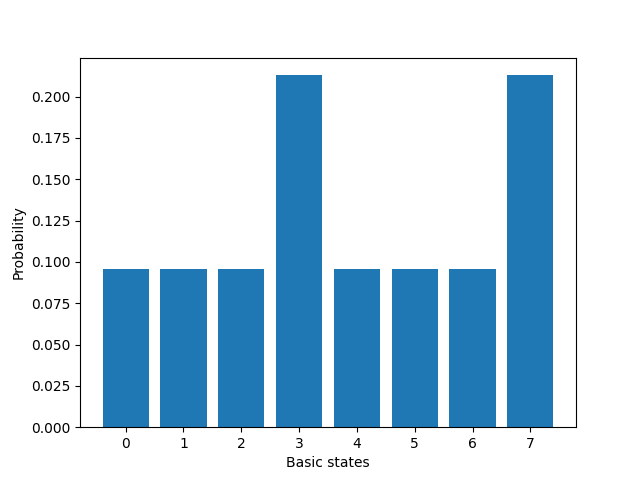
By plotting the probabilities of obtaining each basic state we see that prime factors have been amplified! Factorization via Grover’s algorithm does not achieve exponential improvement that Shor’s algorithm does, but we can see that this construction is simple and a great example to illustrate basic arithmetic!
I hope we can now all see that oracles are not something magical and that there is a lot of work behind their construction! This will help us in the future to build more complicated operators, but until then, let’s keep on learning. 🚀
References¶
- 1
Thomas G. Draper, “Addition on a Quantum Computer”. arXiv:quant-ph/0008033.
About the author¶
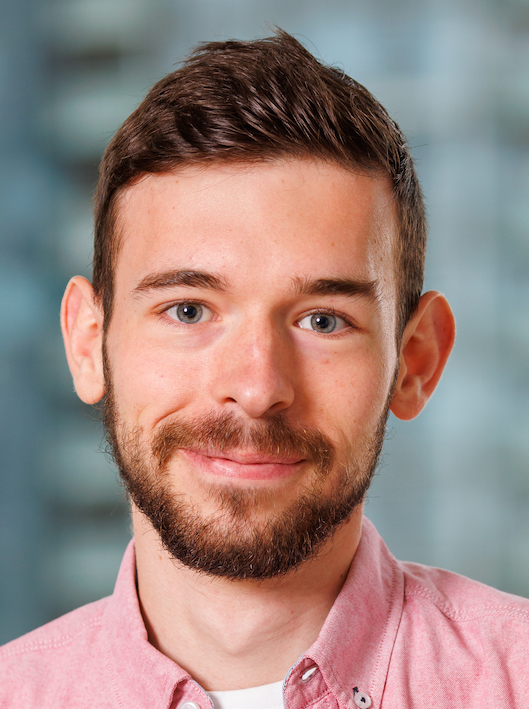
Guillermo Alonso-Linaje
Total running time of the script: ( 0 minutes 1.598 seconds)